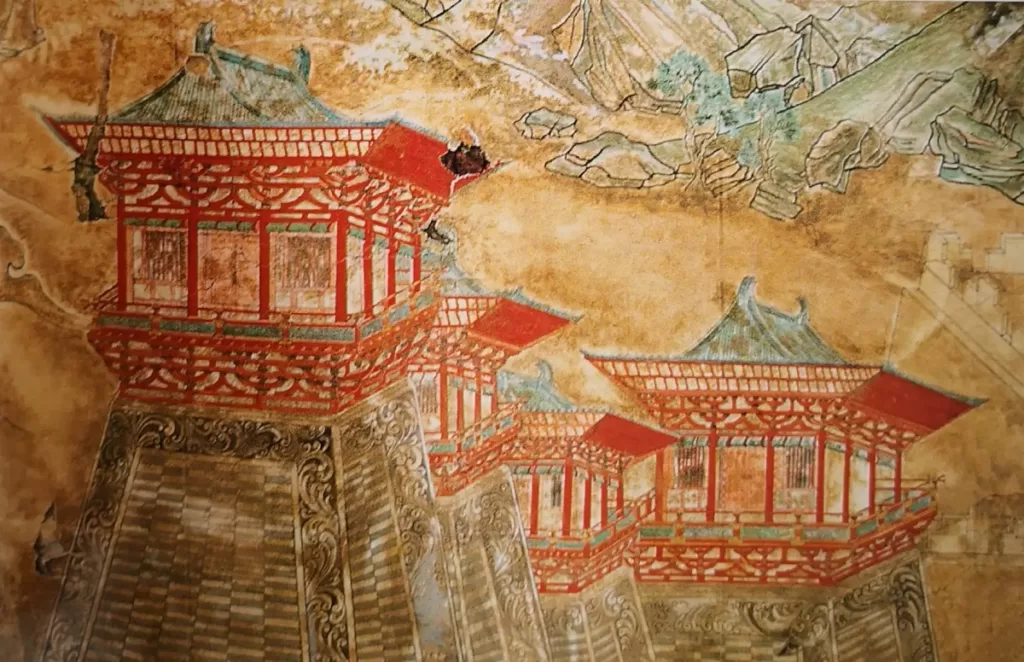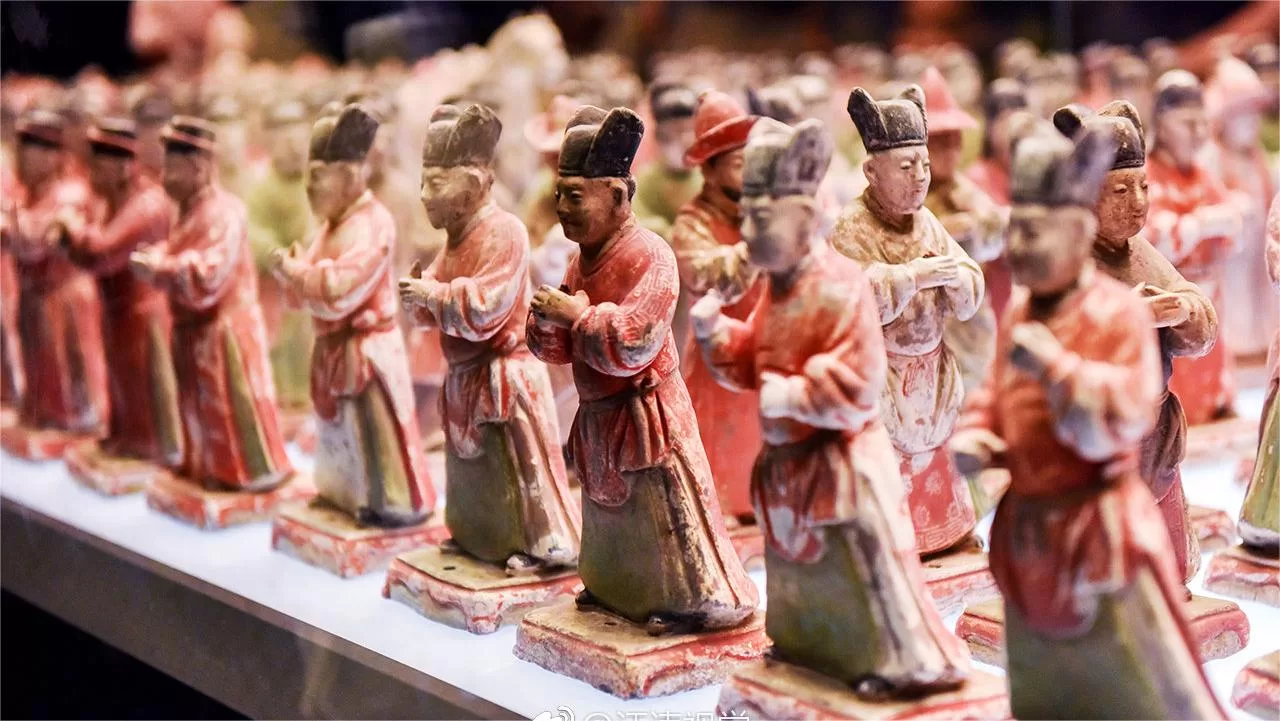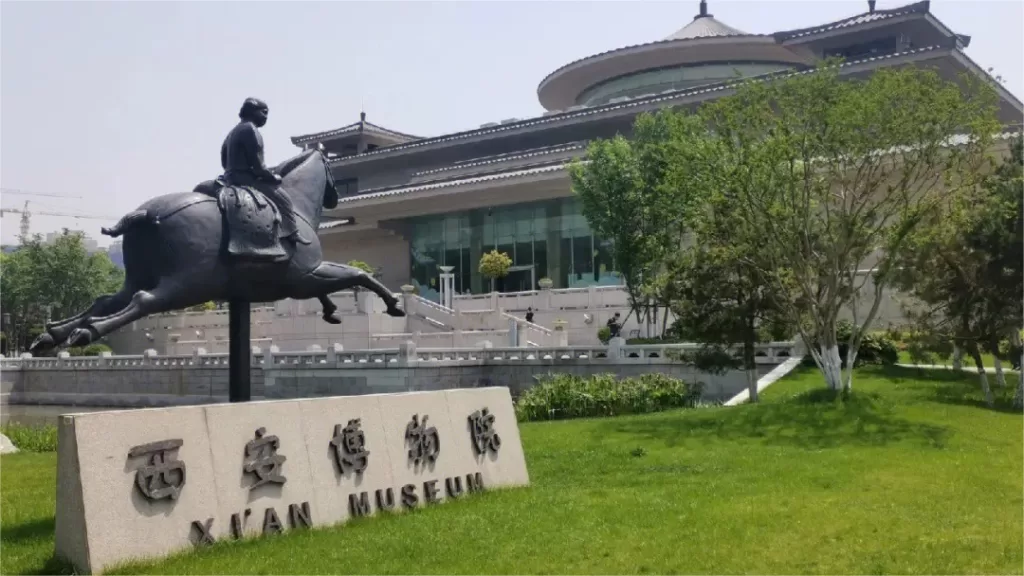The Shaanxi History Museum (陕西历史博物馆), located in Xi’an, China, is the country’s first large-scale, modern, national-level museum. It boasts a remarkable collection of over 1.7 million artifacts, including 762 first-tier cultural relics and 18 national treasures. Two of these items are among the first batch of artifacts restricted from being exhibited abroad, placing the museum among the leading institutions in China’s museum landscape.
Construction of the Shaanxi History Museum began in the summer of 1986, and it officially opened its doors to the public on June 20, 1991, under its current name. The museum covers an area of 65,000 square meters, with exhibition halls spanning 11,000 square meters.
The museum’s collection spans a vast timeline, starting from the simple stone tools used by early human ancestors and extending to a wide array of artifacts from pre-1840 Chinese society. This expansive collection covers over a million years of history, making it an essential destination for those interested in the rich history and culture of China.
Table of Contents
- Basic Information
- Location and Transportation
- Highlights of Shaanxi History Museum
- Vlog about Shaanxi History Museum
- Useful Tips Summarized From Reviews
- Other Museums in Xi’an
Basic Information
| Website | https://www.sxhm.com/ |
| Estimated Length of Tour | 3 hours |
| Opening Hours | 8.30 – 18.00; Last entry: 16.30 (15th March – 14th November) 9.00 – 17.30; Last entry: 16.00 (15th November – 14th March the next year) Closed on Mondays, except for national public holidays |
| Tickets | Free for the general admission, but you need your passport to get a ticket at the box office. Need to pay for special displays, like the Tang Murals, and the price can vary according to the specific exhibition. |
| Telephone Number | 0086-400-029-3806 |
Location and Transportation
The Shaanxi History Museum is situated in the southern suburb of the city, near the Big Wild Goose Pagoda and the Small Wild Goose Pagoda. The specific address is 91 Xiaozhai East Road, Yanta District, Xi’an, Shaanxi Province, China.
Bus: there are several bus stops around the museum, but the nearest one is called Shaanxi History Museum Stop (Shanxi lishi bowuguan 陕西历史博物馆). You can take bus No. 5, 19, 24, 26, 30, 34, 271, 400, 401, 521, 701, or 713 to get there, and once you get off, you will be right in front of the south gate.
Metro: Take subway line 1 or 2, get off at Xiaozhai Station, get out of the station from the northeast exit, and walk about 500 meters to the east to reach the south gate.
Highlights of Shaanxi History Museum
Terracotta Warriors

The Terracotta Warriors are a collection of life-sized clay figures that were buried alongside the first emperor of China, Qin Shi Huang, over 2,000 years ago. Discovered in 1974 near the city of Xi’an, China, the army of warriors was created to protect the emperor in the afterlife. The collection consists of soldiers, horses, chariots, and other figures, each with unique features and expressions. The figures were meticulously crafted and painted, with intricate details on their armor and weaponry. The discovery of the Terracotta Warriors has provided valuable insight into ancient Chinese art, culture, and military practices.
Display of Chinese History

The Shaanxi History Museum features seven permanent exhibitions that provide a comprehensive overview of Chinese history:
- Ancient Shaanxi: This exhibition showcases the remains of early human ancestors, such as the Lantian ape-man and the Dali people, dating back 1.15 million years. It sheds light on the vibrant beginnings of the Chinese civilization.
- The Western Zhou Dynasty: This section displays the rich artifacts and relics from the Western Zhou Dynasty, offering insights into the early Chinese political system, economic structures, ethical values, and the advanced bronze casting technology of the time.
- The Qin Dynasty: Focusing on the terracotta army and other Qin-era artifacts, this exhibition highlights the grandeur of the Qin Empire and its administrative and military prowess.
- The Han Dynasty: Featuring artifacts from the capital of Chang’an, Han mausoleums, and typical Han Dynasty relics, this section portrays the pinnacle of ancient Chinese society, marked by economic prosperity, cultural achievements, and international engagement.
- Cultural Exchange Along the Silk Road: Showcasing the rich cultural and religious artifacts of both agricultural and nomadic cultures in Shaanxi, this exhibition illustrates the merging of different cultures, the spread of Buddhism, and the flourishing of arts and culture.
- The Sui and Tang Dynasties: Highlighting the cultural and artistic zenith of the Sui and Tang periods, this section presents the grandeur of the international metropolis of Chang’an and the Silk Road’s role in connecting East and West.
- The Spirit of Shaanxi: This exhibition focuses on the cultural creativity and spiritual heritage of Shaanxi as a significant regional center in western China, even after the Tang Dynasty, showcasing its continued cultural contributions and resilience.
Tang Dynasty Mural Display

The Tang Dynasty mural display at the Shaanxi History Museum is a distinctive and invaluable collection. It comprises nearly 600 exquisite murals from over 20 Tang Dynasty tombs, covering an area of more than 1,000 square meters. These murals are characterized by their unique architectural styles, vivid and simple depictions of people, distinctive objects, and crisp and lively landscapes.
These murals offer a detailed portrayal of the customs, rituals, clothing, leisure activities, and architectural styles of the Tang Dynasty. They serve as essential visual resources for understanding the social life, particularly the lives of the aristocracy, and the spiritual pursuits of the Tang Dynasty. These murals are not only a testament to the artistic achievements of the era but also provide invaluable insights into the cultural and historical aspects of one of China’s most glorious dynasties.
Horse Culture Display

The horse culture display at the Shaanxi History Museum is a collaborative effort between the museum and 14 cultural institutions from across China, including the Xinjiang Museum, Gansu Museum, Shanxi Museum, and Qinghai Provincial Museum. This exhibition brings together over 150 exquisite artifacts related to horses from various dynastic periods.
Some of the notable artifacts featured in the exhibition include the Qin Dynasty saddle horse from the Shaanxi History Museum, Tang Dynasty tri-colored pottery saddled horses, painted pottery saddled horses from the Xinjiang Uighur Autonomous Region Museum, a Northern Wei sculpture of a monk riding a horse from the Qinghai Provincial Museum, a Shang Dynasty bronze horse from the Ganquan County Museum, and Tang Dynasty equestrian figurines from the Fuping County Confucius Temple Museum.
The exhibition is organized into five thematic units: “Horse Domestication,” “Horses and Transportation,” “Horses and Warfare,” “Horses and Entertainment,” and “Horses and Art.” These units provide visitors with a comprehensive understanding of the significant roles that horses played in ancient China, including in agriculture, daily life, transportation, military campaigns, and cultural expressions. Through a diverse range of artifacts and perspectives, the exhibition sheds light on various aspects of ancient Chinese horse culture, allowing visitors to gain a deeper appreciation of this integral part of China’s history and heritage.
Vlog about Shaanxi History Museum
Useful Tips Summarized From Reviews
Timing: Visit the museum during off-peak hours, ideally between 12 PM to 2 PM when there are fewer visitors. This allows you to explore the exhibits more comfortably without the crowds. Avoid weekends if possible, as they tend to be more crowded.
Strategic Planning: If you’re short on time, prioritize visiting the Fourth Exhibition Hall and the Second and Third Exhibition Halls. The prehistoric section in the First Exhibition Hall is covered in most provincial museums and often has long queues. Focus on the sections with unique or particularly interesting exhibits to make the most of your visit.
Security Check: Be prepared for security checks at the museum entrance. Lighters and other prohibited items are not allowed inside. However, the museum provides drinking water, so bring a water bottle or refillable container to stay hydrated during your visit.
Bring a Fan: If you’re visiting during spring or autumn, consider bringing a handheld fan. The museum doesn’t have air conditioning, and it can get quite crowded and stuffy, especially during peak hours. A fan can provide much-needed relief and make your visit more comfortable.







The Shaanxi History Museum houses an impressive collection that truly lives up to its reputation. The only downside is that the glass display cases in Exhibition Halls 1 to 3 are quite outdated, and with the large number of visitors, the cleanliness is not up to par, which detracts from the overall experience. However, the underground Hejiacun Caves Relics Exhibition Hall is in much better condition.
On such a hot day, the museum surprisingly has no air conditioning. The museum is small but has many exhibits, resulting in a chaotic arrangement. It completely kills any desire to see anything.
In the early morning, we went straight to the third floor where we could comfortably enjoy the exhibits without encountering many other visitors, practically having the place to ourselves. After that, we went to the basement level. Then, during lunchtime, we headed to the second floor, which was much less crowded at that time.
I went to the museum in the morning. There weren’t many people at the entrance, and I held onto the hope that it would be less crowded inside. However, as soon as I entered, I saw a sea of people. To get a close look at the exhibits, I had to queue and wait for gaps to squeeze in. This truly is a museum of an ancient capital! It has four exhibition halls, showcasing each dynasty in chronological order: Zhou,… Read more »
Every exhibition hall was packed with people. We first visited the third exhibition hall, and then the second exhibition hall. Two hours quickly flew by.